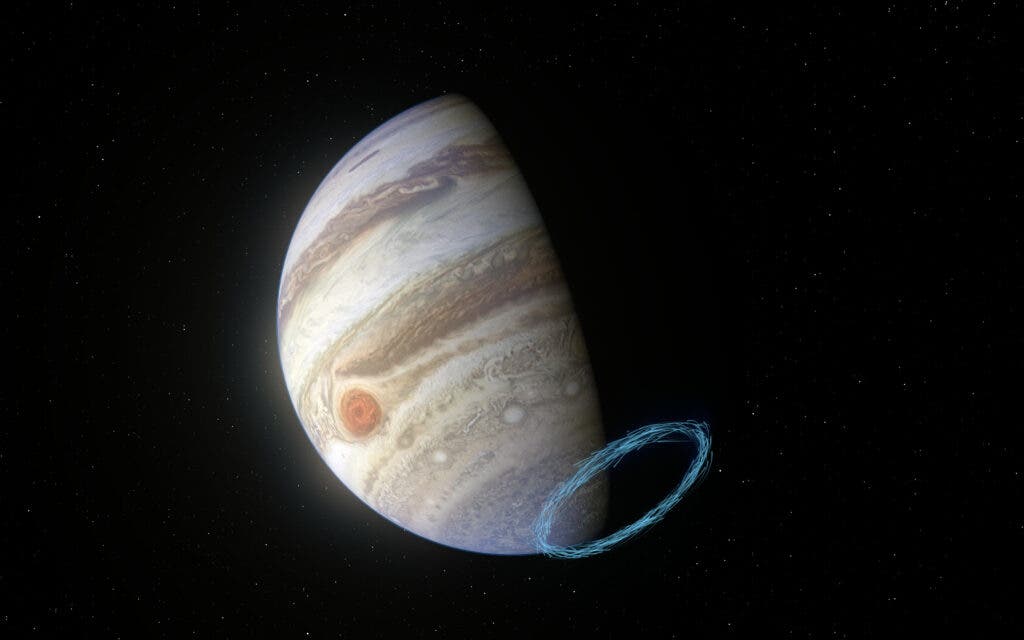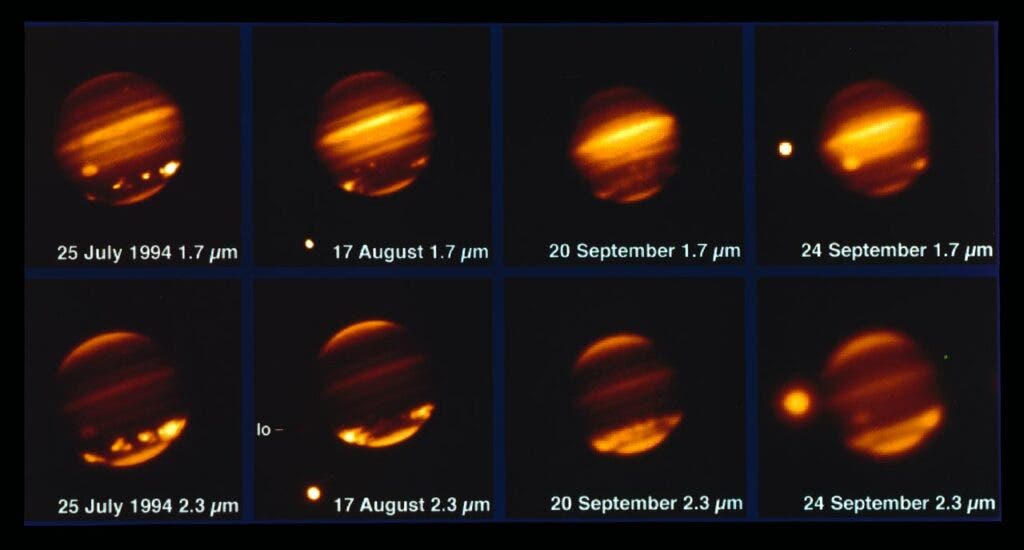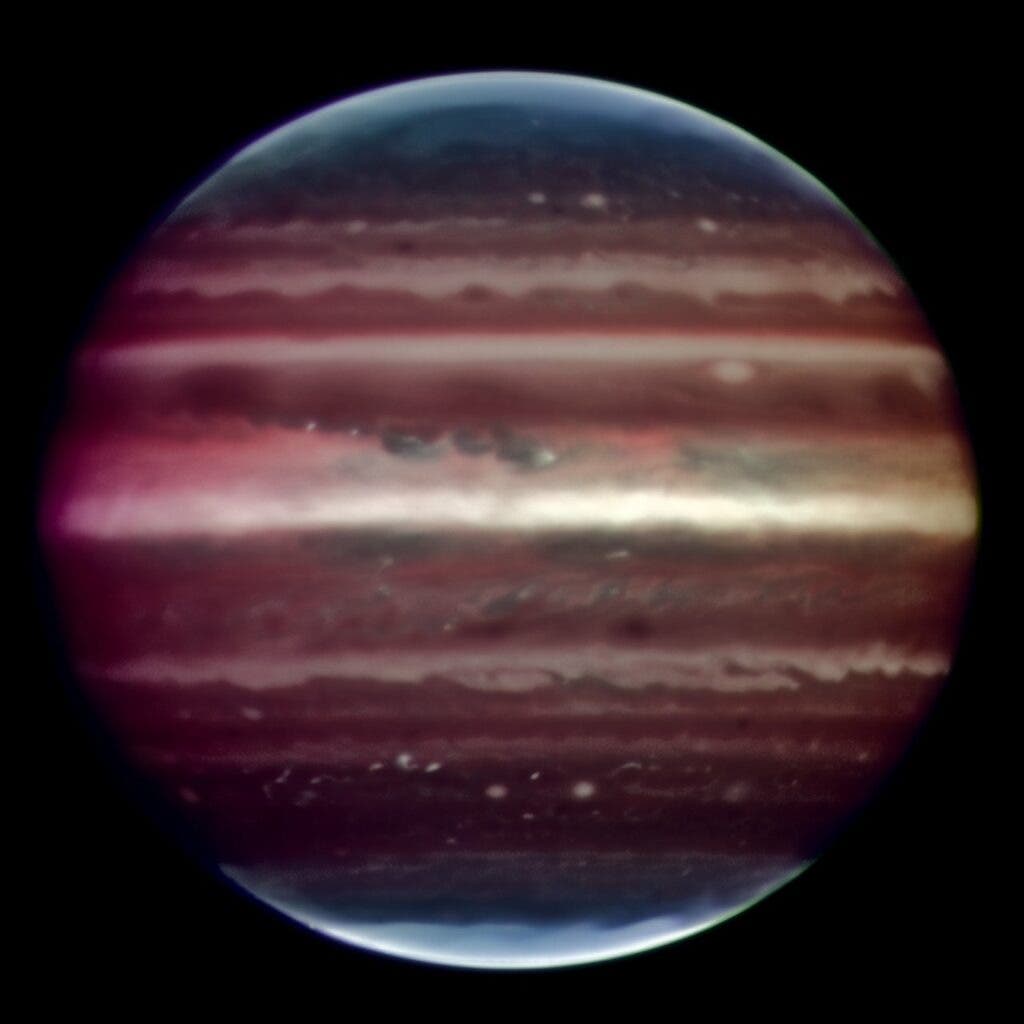Using the aftermath of a comet collision in 1994 astronomers have measured the winds blowing across Jupiter‘s stratosphere for the first time. The team has discovered that these winds raging around the middle atmosphere of the solar system’s largest planet are incredibly powerful–reaching speeds of up to 400 metres per second at the poles.
The team’s findings represent a significant breakthrough in planetary metrology and mark the gas giant out as what the team are describing as a ‘unique metrological beast in the solar system.’

To conduct the research the astronomers diverged from the usual methods used to measure the winds of Jupiter. Previous attempts to measure the gas giant’s winds have hinged on measuring swirling clouds of gas–seen as the planet’s distinctive red and white bands–but this method is only effective in measuring winds in the lower atmosphere. Whereas, by using aurorae at Jupiter’s poles researchers have been able to model winds in the upper atmosphere. But, both of these methods, even when used in conjunction, have left the winds in the middle section of the gas giant’s atmosphere–the stratosphere– something of a mystery.
That is until now. This team of astronomers used the Atacama Large Millimetre Array (ALMA) to track molecules left in Jupiter’s atmosphere by the collision with the comet Shoemaker-Levy 9 in 1994.
“We had to use ALMA’s ability to quickly map Jupiter’s spectral emission at very high spatial and spectral resolution in the submillimeter and observe the Doppler shifts induced by the winds on the spectral line we targeted,” team leader Thibault Cavalié, Laboratoire d’Astrophysique de Bordeaux, France, exclusively tells ZME Science. “We could deduce the wind speeds just like you could deduce the speed of a passing fire engine by the change in frequency of its siren. This spectral line is formed in the stratosphere, giving us access to the winds at this altitude.
“It is the first time we achieve measuring directly winds in the stratosphere of Jupiter, which lacks visual tracers such as clouds.”
Thibault Cavalié, Laboratoire d’Astrophysique de Bordeaux, France.
Cavalié explains that the team had to use ALMA’s ability to quickly map Jupiter’s spectral emission at very high spatial and spectral resolution in the submillimeter and observe the Doppler shifts induced by the winds on the spectral line they targeted.
“We could deduce the wind speeds just like you could deduce the speed of a passing fire engine by the change in frequency of its siren,” the researcher continues. “This spectral line is formed in the stratosphere, giving us access to the winds at this altitude.”
What the astronomers discovered was powerful winds in the middle atmosphere of Jupiter in two different locations. One set of winds conformed to expectations, but the other came as a surprise.
Jupiter’s ‘Supersonic Jet’ Winds
Cavalié explains that the team first found a 200 metres per second eastward jet just north of the equator in ‘super-rotation–meaning that the wind rotates faster around the planet than the planet rotates itself. “Winds at such latitudes were expected from models and previous temperature measurements at these low latitudes,” the astronomer adds.
But, not everything observed by the team conformed to expectations.
“Most surprisingly, we identified winds located under the main UV auroral emission near Jupiter’s poles. These winds have velocities of 300 to 400 meters per second,” Cavalié says. “While the equatorial winds were kind of anticipated, the auroral winds and their high speed were absolutely unexpected.”
To put this into perspective, the fastest winds ever recorded on earth reached a speed of just 103 metres per second–measured at the Mount Washington Observatory in 1931. These auroral winds even beat the winds recorded in Jupiter’s Great Red Spot–an ongoing raging storm on the surface of the gas giant–which have been clocked at around 120 metres per second.
The speed of these jets isn’t their only intimidating quality, however. The jets seem to behave like a giant vortex with a diameter around four times that of our entire planet, reaching a height of around 900 kilometres.
“A vortex of this size would be a unique meteorological beast in our Solar System.”
Thibault Cavalié, Laboratoire d’Astrophysique de Bordeaux, France.
The team’s measurements and stunning discovery, documented in a paper published in the latest edition of Astronomy & Astrophysics, wouldn’t have been possible without a violent incident in Jupiter’s recent history.
Shoemaker-Levy 9 Still has Impact
The impact of Shoemaker-Levy 9 upon the surface of Jupiter was an event–or more precisely a series of events– that had already made history before its effects made this research possible.
The comet broke up in the planet’s atmosphere resulting in a series of impacts that had never been studied prior to 1994, and its somewhat ironic that thanks to this study, Shoemaker-Levy 9 is still having an impact today. The comet left traces of hydrogen cyanide swirling in Jupiter’s atmosphere which the team was able to track.

“The team measured the Doppler shift of hydrogen cyanide molecules — tiny changes in the frequency of radiation emitted by the molecules — caused by their motion driven by stratospheric winds on Jupiter,” says Thomas K Greathouse, Senior Research Scientist at Southwest Research Institute (SwRI), responsible for the development of the study and analysis of the observational results. “
“The high spectral and spatial resolution and the exquisite sensitivity of the observations at the wavelengths covered by ALMA allowed us to map such small Doppler shifts caused by the winds in the stratosphere all along the limb of Jupiter.”
Thomas K Greathouse, Senior Research Scientist at Southwest Research Institute (SwRI).
The fact that the team was able to obtain all the measurements they did with just 30 minutes of operating time with ALMA is a striking testament to the power and precision of the 66 antennas that make up the telescope array located in the Atacama Desert of Nothern Chile, currently the most powerful radio telescope on Earth.
“It was the availability of ALMA that made these measurements possible. Previous radio observatory facilities did not have the combination of spectral and spatial resolution along with the high sensitivity needed to measure the winds as was done in this study,” Greathouse tells ZME Science. “Making further observations using ALMA to capture Jupiter at different orientations will allow us to study these winds in more detail and allow us to look for temporal variability in them as well.
“Additionally, more extensive measurements will be possible from the JUICE mission and its Submillimetre Wave Instrument slated for launch in 2022.”
The Future of Jupiter Investigations
JUICE or JUpiter ICy moons Explorer is the first large-class mission in the European Space Agency’s (ESA) Cosmic Vision program and will arrive at Jupiter in 2029 when it will begin a three-year mission observing the gas giant in intense detail.
“This is why science is so much fun. We have worked hard to understand a system–Jupiter’s stratosphere in this case–as best we can, we make our predictions about something–stratospheric wind behaviour–and then go test those predictions. If we are right, fantastic, we move on to the next problem, but if we are wrong we have learned something new and unique and can then continue making further studies to come to a more complete understanding of the system.”
Thomas K Greathouse, Senior Research Scientist at Southwest Research Institute (SwRI).

For Cavalié, who has been involved with the measurement of Jupiter’s winds since 2009, the future is bright for such investigations and what they can tell us about the solar system’s largest planet and gas giants in general. “We now want to use ALMA again to characterize the temporal variability of the equatorial winds,” the astronomer says. “It is expected from temperature measurements and models that the direction of the equatorial winds should oscillate from eastward to westward with a period of about 4 years.”
The scientist is also clear, just because he and his colleagues have achieved a first, that doesn’t mean they are prepared to rest on their laurels. There are a lot of exciting developments on the way, and thus a lot of work to be done.
“We also want to observe the auroral winds during a Juno perijove pass to compare our data with observations of the poles by the spacecraft to better understand their origin and what maintains them,” he explains. “In addition, this study is a stepping stone for future investigations to be conducted using the same technique with JUICE and its Submillitre Wave Instrument.”
In addition to these missions, the ESO’s Extremely Large Telescope (ELT)–due to start operations later this decade–will also join investigations of Jupiter and should be capable of providing highly detailed investigations of the gas giant’s atmosphere.
“Jupiter and the giant planets are fascinating worlds. Understanding how these planets formed and how they work is a source of daily motivation, especially when working with world-class observatories like ALMA and participating in space missions to explore Jupiter and its satellites.”
Thibault Cavalié, Laboratoire d’Astrophysique de Bordeaux, France.






